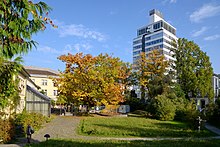Old Botanical Garden, Zürich

Alter Botanischer Garten Zürich
|
|
| Date opened | Founded in 1837 |
|---|---|
| Location | Pelikanstrasse 40, CH-8001 Zürich |
| Coordinates | Coordinates: 47°22′16″N 8°32′01″E / 47.37111°N 8.53361°E |
| Land area | 5 acres (2.0 ha) |
| Website | Official website (German) |
The Old Botanical Garden (German: Alter Botanischer Garten) is a botanical garden and arboretum in the Swiss city of Zürich. The garden is, among the neighbored Schanzengraben moat and the Bauschänzli bastion, one of the last remains of the Baroque fortifications of Zürich, that was begun in 1642.
The Garden is located on the former zur Katz bastion in the city centre near the Sihlporte area. Opening times are daily from April to September 7:00–19.00 (7 pm), October to March 8:00–18:00 (6 pm). Trams 2 and 9 stop at the nearby Sihlstrasse stop. Although the Old Botanical Garden is owned by the University of Zurich, it should not be mistaken for the Botanical Garden of the University of Zurich, opened in 1977 and located at Zollikerstrasse in the Weinegg quarter of the city. The present facilities also house the ethnological museum (Völkerkundemuseum) of the University of Zürich.
The origins of the first botanical garden base on Conrad Gessner's (1516–1565) private herbarium. A Gessner descendant, Johannes Gessner (1709–1790) who was a physician and naturalist, founded Zürich's first botanical garden in 1746, in co-operation with the Naturforschende Gesellschaft Zürich (Zürich Botanical Society).
In 1833 the Canton of Zürich changed this first location to the so-called Schimmelgut when the University of Zürich was founded. On dissolution of the ramparts zur Katz in 1837, the still existing plant at the Schanzengraben moat was built. The garden was designed by the University's gardener Leopold Karl Theodor Fröbel (1810–1907). In 1851 its Palmhaus (a greenhouse) was opened – constructed of glass and wood, in 1877 the octagonal glass pavilion got an iron frame. Today, the pavilion is primarily used for concerts, theater and exhibitions.
...
Wikipedia
